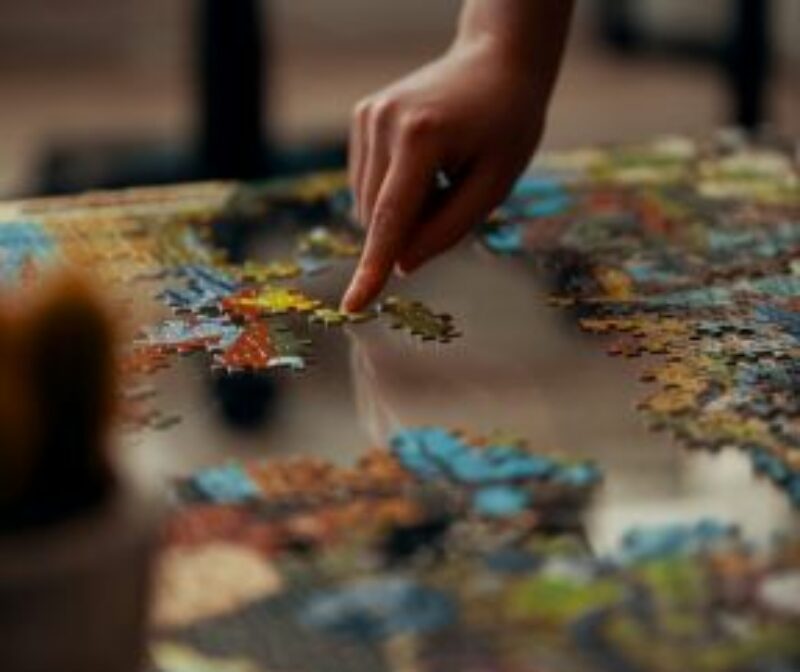From dysregulation to rest
Why do we need rest? In a study by the American Psychological Association, 37% of Americans rated their mental health as fair or poor, up from 31% the year before (see 2022 Healthy Minds Monthly Poll). One contributor to wellbeing is a regular pattern of downtime, like taking Sabbath. The Journal of Psychology and Theology in 2022 reported that clergy who practiced sabbath experienced a greater sense of accomplishment at work, reported better spiritual health and wellbeing, and had fewer symptoms of anxiety. Biologically, patterns of rest support our autonomic nervous system and keep us from a state of fight, flight, or freeze. Many of us have experienced anxiety late at night that resolves itself after a good night’s rest or rejuvenation that occurs by putting the phone down or going for a walk with a friend.
Our bodies were created to rest, and we have to let them relax in order for them to function well. Researcher, Deb Dana, describes how our ventral vagus nerve is the necessary ingredient for regulation that prevents us from defaulting into fight or flight. Our ventral nervous systems help us feel safe and secure, it helps us connect to ourselves giving us the capacity to then connect with others. This biological process is known as neuroception. According to Polyvagal Theory, which was developed by Stephen Porges, we need rest to activate our ventral vagus nerve. The pace of life and the messaging in the media can activate our emotions leading to dysregulation of our nervous systems. Without rest, our bodies remain in a state of threat, so that our prefrontal cortex can no longer plan and function effectively. Deb Dana highlights that we each have unique nervous systems shaped by biology and our experiences, so the way in which we each practice rest is going to be unique.
Regulation is not just about calming ourselves. In our previous post we talked about how we were created to practice rhythms in community, but why is this necessary? This is because humans co-regulate. Co-regulation is defined as warm and responsive interactions that provide support and that help someone understand, express, and modulate his or her feelings, thoughts, and behaviors (Gillespie, 2015). Dr. Dan Siegal, who has been a pioneer in the field of interpersonal neurobiology, writes about the 4 S’s of co-regulation. These 4 Ss are feeling safe, seen, soothed, and secure. The best thing that caregivers can provide to those around them is not a thing, it is their presence. Presence is what enables someone to feel safe, seen, soothed and secure. Presence is what enables someone to lean into rest. Rhythms of rest within a community can provide psychological safety that enables us to down-regulate and activate our parasympathetic nervous system, where we can rest and re-connect. And the human brain is profoundly social. Studies have shown that when a person is with a loved one, they experience less pain than when they are by themselves. Humans co-regulate by mirroring the regulation of others – or the dysregulation – so communal rituals can create a cascade of calming responses or they can lead to chaos. In the late 1910s, anthropologist Bronislaw Malinowski found that people rely on rituals when they are experiencing a host of new situations where the outcome is unknown. Rituals, like communal worship, singing, cooking and sharing a meal with others, and just being in the presence of others can be powerful tools that enable us to not only self-regulate but to help others co-regulate as well.
But self-regulation and co-regulation may feel really challenging to do when the people around you are dysregulated or you are isolated from others often. The challenge is that co-regulation can feel draining when we are interacting with others who haven’t learned to self-regulate or have been living in a state of dysregulation (which could be due to a multitude of different factors including trauma). This is why we have to create space to learn how to self-regulate. Researchers, such as Mul et al. (2018) have found that people who are more attuned and aware of their own bodily processes are able to better attune to the needs of those around them. This process of self regulation is known as interoception, and it is a powerful tool for us to not only regulate ourselves but also be able to empathize and attune to those around us. Sometimes self regulation looks like us needing to microdose with rest to avoid burnout. We need spaces of solitary restoration and communal ones, and the degree to which we need both will depend on our personalities and lived experiences. Just because you find one ritual to be helpful for your own regulation does not mean that your spouse, your child, or your friend will have the same experience. So as we set out to create rhythms that enable us to regulate and co-regulate, we encourage you to experiment with what works for you and others in your family or community. Others may not experience the rhythms in the same way as you, but these rhythms of work and rest, regardless of your religious tradition, can support spiritual health and well being when they are practiced consistently.
A Guided Gratitude Practice:
The Basic Glimmer Practice helps you learn to notice and name glimmer moments – to stop and feel the spark of joy a glimmer brings (this practice was taken from Deb Dana who founded Rhythms of Regulation.
See: What are the cues that you have found a glimmer? What happens in your body that lets you know you are in a glimmer moment? What do you do when you feel that spark of energy? What thoughts arise? What emotions do you feel?
Stop: Now that you know the cues, use them to notice glimmers as you move through your day. Glimmers happen regularly, but because they are micro-moments you need to be on the lookout for them. Look for predictable glimmer moments in specific places, with particular people, at certain times. Find the ways glimmers routinely appear. Be open to the unpredictable glimmers that may also appear. When you recognize one of the cues you identified, stop and find the glimmer.
Appreciate: Create an easy way to acknowledge a glimmer as it happens. You might repeat a simple phrase or make a small movement (perhaps your hand on your heart or a finger pointing toward the glimmer) each time you find a glimmer. Notice all the different feelings your glimmers bring. Spend several seconds in appreciation letting the glimmer land in your system.
Remember: Find ways to keep track of your glimmers. Experiment with ways to build your collection and create a personal glimmer library.
Share: When you share your glimmers with someone else, they come alive again in the remembering and retelling. You might text your glimmers to a friend or make talking about daily glimmers a family ritual. You could find a glimmer buddy or create a glimmer group.
For more meditations on regulation visit: https://www.rhythmofregulation.com/audiomeditation
References for further exploration
https://www.psychologytoday.com/us/blog/designed-happiness/202112/the-work-rest-investing-in-yourself-sabbatical
https://news.gallup.com/poll/175400/workers-sense-identity-job.aspx
https://www.ncbi.nlm.nih.gov/pmc/articles/PMC5342845
https://psychcentral.com/blog/how-to-really-rest#what-is-rest-really
https://www.health.harvard.edu/blog/astounding-increase-in-antidepressant-use-by-americans-201110203624
https://pubmed.ncbi.nlm.nih.gov/20921542/
https://newsinhealth.nih.gov/2013/04/benefits-slumber
https://www.ncbi.nlm.nih.gov/books/NBK453237/
https://www.sciencedirect.com/science/article/abs/pii/S1074742718301394
https://www.ncbi.nlm.nih.gov/pmc/articles/PMC10239033/
https://health.clevelandclinic.org/foods-that-give-you-energy
https://www.ncbi.nlm.nih.gov/pmc/articles/PMC5409706/#:~:text=Eggs%20and%20fis
h%20are%20higher,the%20highest%20content%20of%20melatonin.
https://www.scientificamerican.com/article/why-rituals-work/
How to set yourself free with ritual
Continue Exploring

Spirituality
Rhythms and Rest (Part 1)
Why do we need spiritual practices like Sabbath? Is it enough to just rest? This 2-Part series answers these questions and more.

Mindfulness
Screen Time: Here’s What Happened When I Took my Kids’ Screens
Writer Amy Dunn tells us that taking screens away marked her. "I watched my kids immediately become completely lost in their own imaginations for not just minutes, but hours and hours."

Practices
Burnout Culture: Is it Possible to Rest and Achieve?
How do we address the problem of burnout in our modern society?

